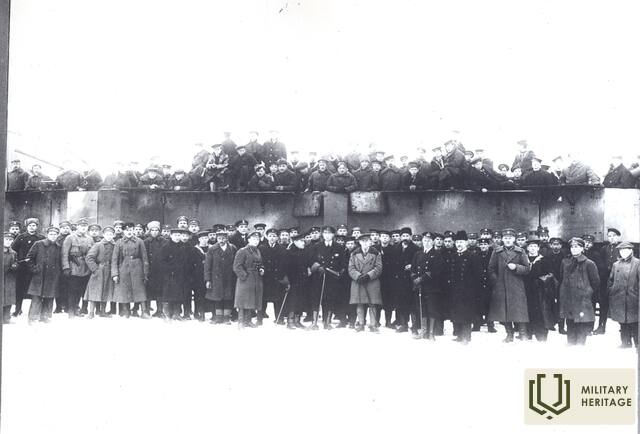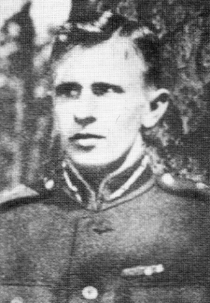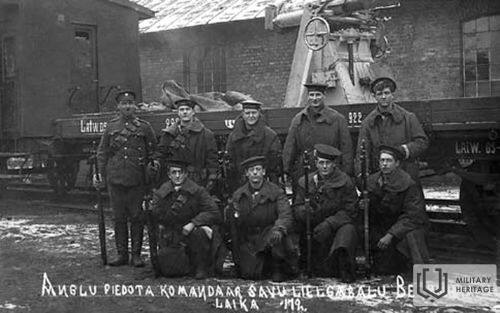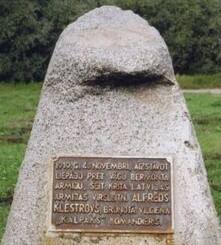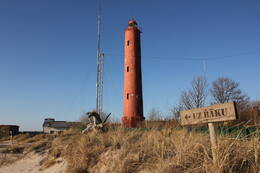Latvian Army armored train No. 5 or "Kolpaks"
Latvian Army Armoured Train No.5 or "Kalpaks" was a light armoured train in the Latvian Armed Forces in 1919.
The train was clad in metal plates, had only two armored cars, one partially armored locomotive and a platform, the side of which could be used as a cover for firing, as well as an internal communications system. The armored train was built in the workshops of the Liepāja railway depot and put into operation on October 28, 1919.
Built in the Liepāja railway workshops under the direction of engineer SPROGE on the orders of Colonel DANKERS. After complete formation, the train's armament: 2 wagons with machine guns (Lewis system), self-propelled guns and some Maxim system machine guns; 1 tender with 1 English 3-inch naval gun of the new type, 1 quadruple PULMAN platform with 2 English naval guns (older type) at the ends and 1 Vickers 38 mm anti-aircraft gun in the middle, 1 freight locomotive, 1 wagon with a 60 cm searchlight. The wagons and the locomotive are armed from above and on the sides, the gun platforms are open-topped on the sides. The armor is made of ship boiler tin approximately 15 - 20 mm thick. In addition, several freight wagons are equipped for living and some platforms with railway repair materials. All rolling stock was received in a poor stock, which was at the disposal of the Liepāja operation at that time. The name “Kolpaks” was given to the train by order of Colonel DANKER at the suggestion of the then assistant chief of the Liepāja operation BĒRZIŅA.
Related timeline
Related objects
Monument to Latvian Army Lieutenant Alfreds Klestrovs, battle site of the armoured train "Kalpaks"
Lieutenant Commander of the Armoured Train Lieutenant Alfred Klestrov , born 8 March 1897 in Liepaja. Graduated from Liepāja City School, then from the surveyors' school in Riga.
Conscripted into the Russian Army during World War I, graduated from the Battalion School in Moscow. Served on the Romanian front, fought in Ukraine. When Ukraine was occupied by German troops, he returned to Riga.
The Order was awarded in 1922
Conscripted into the Latvian Army in the spring of 1919, served in the additional battalion of the 3rd Latgale Division. In October 1919 he was assigned to the armoured train "Kalpaks" as a commander.
On 4 November 1919, when the Germans attacked Liepāja, the commander of the armoured train "Kalpaks", Lieutenant Alfred Klyestrov, under heavy artillery and machine-gun fire, counter-attacked and got behind enemy lines with the armoured train. Unable to open cannon fire, he led his team in a bayonet fight and dispersed the enemy, thus contributing to the withdrawal of the Bermontese attack, but he himself fell in this battle to a bullet from German soldiers who had entrenched themselves at home and remained behind the Latvian army soldiers.
In 1935, a memorial plaque was erected at the place of death of Lieutenant Alfred Klestrovs, commander of the armoured train "Kalpaks", at the junction of the Liepāja railway and Liepāja-Grobiņa highway.
Monument to the soldiers who fell in the battles for the liberation of Liepāja at the Northern Cemetery
The main memorial site of the War of Independence in Liepāja is located at the Northern Cemetery, where a monument designed by K. Bikše - Pikše to those who fell in the liberation battles near Liepāja was unveiled on November 24, 1924. The monument was damaged during World War II, but was restored in 1989.
Akmeņrags Lighthouse and the fate of the "Saratov"
The Akmeņrags Lighthouse is located in Saka parish, 10 kilometres southwest of Pāvilosta. The top of the lighthouse can be reached by a spiral staircase and it offers views of the sea and the surrounding forests. Standing at 37 metres high, the current lighthouse tower was built in 1921, while the previous lighthouse was destroyed during World War I.
The Akmeņrags Lighthouse stands out among other lighthouses in Latvia, as it is located in one of the most dangerous places for sailing in the entire Baltic Sea coast. The signal beam of the lighthouse marks a rocky bank, which extends approximately two nautical miles or 3.7 kilometres into the sea in a north-western direction. The depth of the bank is just over two metres. The location of the lighthouse has remained unchanged, but the coastline has been receding over the years. Although a navigation light has been here since 1879, Akmeņrags has seen several shipwrecks. The most notable occurred in September 1923 when a Latvian steamer named Saratow struck the ground. In 1919, Saratow briefly served as the seat of the Latvian Provisional Government. Akmeņrags used to be home to a border guard post, and buildings of the Soviet Army are can be viewed here.
Berth of the ship "Saratov" in Liepaja
The berth of the "Saratov" is located in Liepaja, at 59 Old Harbour, near the boat docks.
Built in 1888 in Copenhagen by the shipyard Buvmeistar & Wain under the name "Leopold II", in 1911 it was bought by the joint-stock company Russian North-West Shipping and renamed "Saratov", with the Latvian Aleksandrs Remess becoming the ship's captain.
In May 1915, when Liepaja was occupied by German troops, the Saratov was in a damaged state in the harbour.
On 10 January 1919, the steamship Saratov was taken over by the Latvian Provisional Government. From April to July 1919, after the "16 April coup d'état", the Provisional Government headed by K. Ulmanis was on board the Saratov and was forced to take refuge under the protection of the Allied fleet.
On 8 July 1919, after the delivery of the Provisional Government of K. Ulmanis to Riga, the steamers were used for traffic between Riga, Ventspils and Liepaja.
Under the terms of the Peace Treaty of 11 August 1920 between Latvia and Soviet Russia, the steamship Saratov had to be returned to the Soviet side. On 2 January 1923, the steamship was handed over to a Soviet Russian representative. On 15 January 1923, the steamship "Saratov" was wrecked off Akmenrags.
In 1936 the Latvian Maritime Department sold the wreck to a company, which scrapped it and handed it over to the Liepaja Cloth Factory.
The actual berthing location of the ship “Saratov”
The actual berth of the ship “Saratov” is located in Liepāja, at Vecā ostmalā 59 near the boat piers, but the memorial is located in the immediate vicinity of the Liepāja special economic zone.
Built in 1888 in Copenhagen at the shipyard "Buvmeistar & Wain" under the name "Leopold II". In 1911, it was bought by the Russian Northwest Shipping Company and renamed "Saratov", with Latvian Aleksandrs Remess becoming the ship's captain.
In May 1915, when Liepāja was occupied by German troops, the “Saratov” was in the harbor in a damaged condition.
On January 10, 1919, the steamer “Saratov” was taken over for the needs of the Latvian Provisional Government. From April 1919 to July 1919, the Provisional Government led by K. Ulmanis was on board the ship “Saratov” after the “April 16 Coup”, which was forced to seek refuge under the protection of the Allied fleet.
On July 8, 1919, after the Provisional Government of K. Ulmanis was brought to Riga, the steamer was used in traffic between Riga, Ventspils and Liepāja.
According to the terms of the peace treaty between Latvia and Soviet Russia of August 11, 1920, the steamer “Saratov” had to be returned to the Soviet side. On January 2, 1923, the steamer was handed over to the representative of Soviet Russia. On January 15, 1923, the steamer “Saratov” was lost near Akmeņrags.
In 1936, the Latvian Maritime Department sold the shipwreck to a company that raised it and handed it over for scrap metal to the Liepāja Wire Factory.




